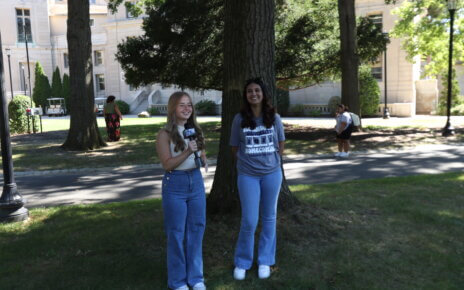In order to maintain campus safety during the COVID-19 pandemic, it is vital that students wear face masks.
The Centers for Disease Control (CDC) “recommends that you wear masks in public settings around people who don’t live in your household and when you can’t stay six feet away from others. Masks help stop the spread of COVID-19 to others.”
Because the coronavirus is mainly transmitted by airborne respiratory droplets produced when an infected person talks, coughs, or sneezes, as per the CDC, it is imperative that masks be worn correctly to receive and provide the most protection.
“Masks should completely cover your nose and mouth and fit snugly under the chin and sides of the face without gaps. They should be made of at least two or more cloth layers,” advised Kathy Maloney, Director of Health Services at Monmouth.
A study by The Proceedings of the National Academy of Sciences found that the use of face coverings reduced the number of infections by over 78,000 in Italy from April 6 to May 9 and by over 66,000 in New York City from April 17 to May 9.
The CDC offers guidelines for properly wearing a face mask. Before putting it on, you must first wash your hands. Then, put it over your mouth and nose, securing it under your chin. Next, fit it as snugly as you can to the sides of your face. Lastly, make sure you can breathe easily.
According to the World Health Organization (WHO), prolonged use of medical masks does not lead to CO2 intoxication or oxygen deficiency when worn correctly.
To take off your mask, you should first untie the string from behind your head or stretch the ear lobes, depending on which type of mask you have. Be sure to only handle the mask by the loops or ties. Then, fold the outside corners together and wash your hands immediately after removing.
Cloth masks should be washed frequently with regular laundry, but disposable masks should never be reused. Surgical masks and N95 masks should be reserved for healthcare workers.
Are there any alternatives to wearing face masks? Senior biology student Jesse Bragger said that she would prefer to wear a gaiter rather than a medical surgical mask when exercising because she finds it to be more comfortable and breathable. However, the CDC does not recommend face shields or gaiters, as their effectiveness is currently unknown.
Not all people who have COVID-19 display symptoms such as coughing, fever, and shortness of breath. They may be unaware that they have it, which is why everyone must wear a mask. If an asymptomatic person who tests positive for the virus wore a mask in public, the risk of spread would be minimal.
Although it is both campus policy and state regulation that an individual must wear a mask when they are within six feet of another person, you might see people wearing a face mask incorrectly or not wearing one at all.
Josephine Gargiulo, a senior English elementary education student, said, “Although I wish I could correct them, I feel awkward because I don’t know if it is my place to tell them what to do.”
Grabbing a cloth mask for school in the morning might take some getting used to, but it’s up to the campus community to protect our fellow Hawks.
There are many different types of face masks. If you need assistance in finding which mask is right for you, Health Services at Monmouth University is available for assistance.
According to the WHO, the use of a mask should be paired with social distancing, frequent hand washing, and making sure you avoid touching your face and mask for maximum protection. Although some may find wearing a mask to be annoying or tedious, it is a necessary precaution that protects the safety and well-being of all.
PHOTO COURTESY of Monmouth University



